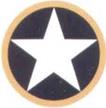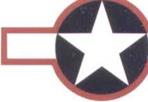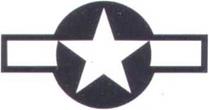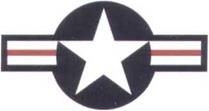Some confusion had arisen concerning which service was responsible for developing collapsible decoys for camouflage purposes. The Material Center at Wright Field, as directed by the Dir. of Mil. Req., issued a memo dated June 8, 1942, stating that the responsibility for development of materials, methods, and technique relating to camouflage was as follows:
Corps of Engineers – all camouflage except protective coloration of aircraft.
Army Air Forces * Protective coloration of aircraft.
|
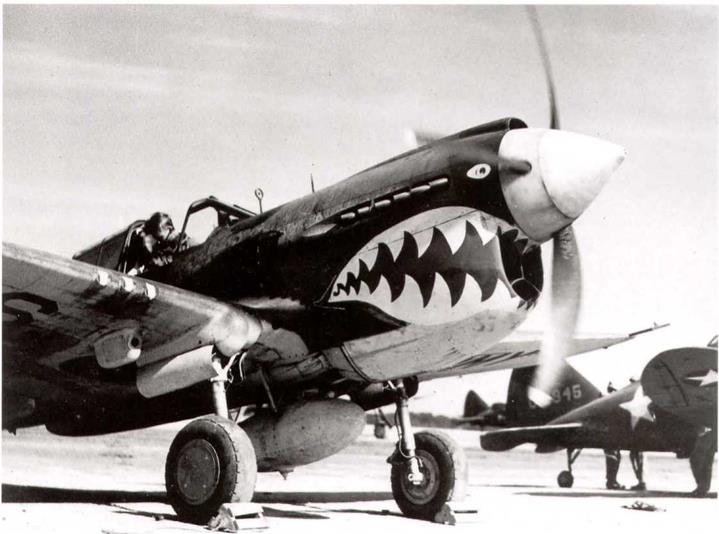
31366 AC
|
Curtiss P-40E of the 23rd FG, 14th AF, at Kunming, China, in early 1942. Warming up, it shows the fearsome AVG shark marking very well. Note that the aircraft behind are the very rare Republic P-43As; only 80 were built. The nearest one is 40-2945. (USAF)
Camouflage defined for AAF Consolidated PBY-5A aircraft, June 10,1942.
The Joint Aircraft Committee decided on June 10, 1942 that the standard basic camouflage scheme for AAF operational aircraft would now refer only to land based aircraft, and that the Consolidated PBY-5A aircraft being procured for the AAF would be camouflaged in accordance with the previously approved standard Navy “ship-based aircraft and flying boats” camouflage scheme. As a result, the Material Center issued a memo on June 13, 1942, stating that the standard basic camouflage scheme for all AAF Consolidated PBY-5 aircraft was:
a. Surfaces seen from above to be painted non-specular blue-gray.
b. Surfaces seen from below to be painted non-specular light gray.
The memo also stated that the term operational aircraft referred only to land based aircraft used by the AAF, with the exception of amphibians.
Continued Requests for the use of White anti-submarine aircraft camouflage.
A decision on whether or not to use white paint as a camouflage on anti-submarine aircraft still had not been made by June 29,1942, when No. 1 Bomber Command, New York, sent a request to the Commanding General, Air Forces, EDC, and First Air Force, Mitchcl Field. This asked that they be authorized to camouflage, and be furnished with the materials to camouflage, all aircraft of their Command engaged in patrol operations.
They requested that the paint should be No. 1 white, or “just off-white”
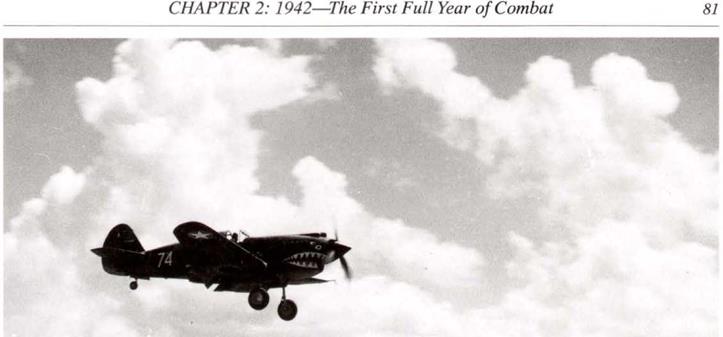
|

Curtiss P-40A, aircraft number “74” of the 23rd FG, 14th AF, landing at Kunming, China, on September IS, 1942. (USAF)
|
|
|
Another Lockheed P-322, AF116, in RAF camouflage, which appears to be in much better shape than the P-322, AF207. Note the P-43,41-678, in background, plusAT-6s. (USAF via Gerry R. Markgraf)
|
|
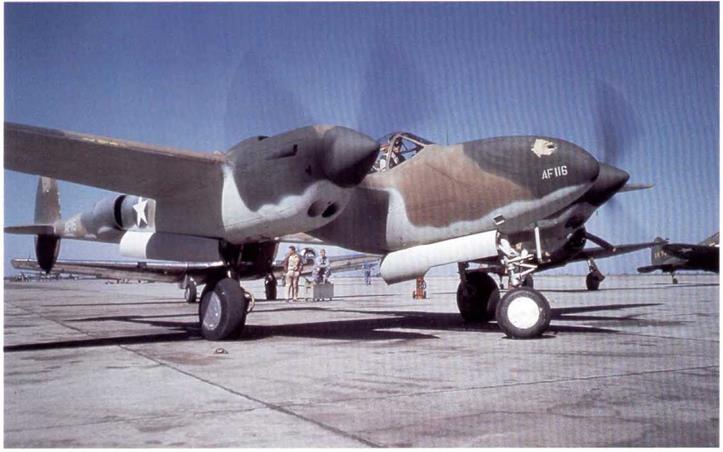
In response to this, on July 2, 1942, HQ Air Forces EDC and First Air Force requested that the Material Center, WF, should allow the First Air Force to conduct experiments in camouflage.
The Material Center replied on July 13, 1942, that action on this type of camouflage had been delayed by the lack of a satisfactory camouflage paint for de-icers, but that a contract for the development of such a paint was going to be made to the Goodrich Tire and Rubber Co. They went on to state that oyster gray finishes for metal and fabric covered surfaces could be prepared locally by tinting white camouflage enamel (Shade 46, Bulletin 41) with black camouflage enamel of the same spec.. If conditions required flight tests before deicer paint could be obtained, they suggested that water paints to Spec. 14057 be used.
On July 30, 1942, HQ Air Forces EDC requested that the 1 Air Service Area Command, Heinpsted, NY, obtain data on the number and types of aircraft that would be used in the white paint tests.
On July 23, 1942, HQ 1 Bomber Command forwarded the following list of aircraft to be painted:
1st Air Service Area Command
|
Mitchel Sub Depot
|
ІШ
|
No.
|
|
HQ Sq, 1BC
|
B-34
|
2
|
|
393rd BS
|
B-25
|
10
|
|
Westover Sub Depot
|
|
13th BG
|
B-25
|
14
|
|
B-18
|
13
|
|
Langley Sub Depot
|
|
2nd BG
|
B-17
|
12
|
|
B-18
|
3
|
|
B-34
|
6
|
|
2nd Sea Search Attack
|
B-18
|
12
|
|
39th BG (Dover)
|
B-25
|
13
|
|
Pope Sub Depot
|
|
79th BS
|
B-34
|
14
|
|
396th BG
|
A-29
3rd Air Service Area Command
|
8
|
|
Orlando Sub Depot
|
|
78th BG (Jacksonville)
|
B-34
|
12
|
|
Morrison Sub Depot
|
|
80th BS (Miami)
|
B-18
|
6
|
|
B-34
|
10
|
|
76th BS (Miami)
|
A-29
|
10
|
|
309th BG (Miami)
|
B-25
|
12
|
|
Mobile (Ala.) Depot
|
|
433rd BS
|
A-29
|
7
|
|
B-34
|
5
|
The HQ 1 Bomber Command wanted to have this repainting done as soon as possible, as all of the aircraft were being used on combat missions. There was a misunderstanding as to the extent of the repainting and testing that was actually going to be done and the repainting was delayed until later.
|
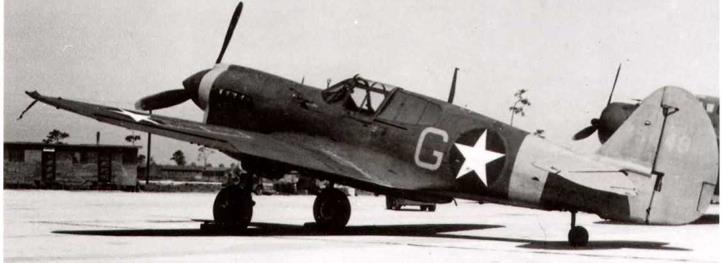
Curtiss P-40E-CU, 41-5449, one of a hatch of 820. Location and unit unknown. The nose hand and entire tail area appear to he overpainted rather thinly in identification yellow. Most probably in the US, note the large concrete ramp area. (Harry Gann)
|
T. O. 07-1-1 Amended to add Medium Green patches to wings and revises insignia requirements, July 10,1942.
T. O. 07-1-1 was amended to include a new paragraph l. f. (1) (c) and revised paras. 5.a. and 6, l. f. Use of Special Color of Camouflage Materials.
(1) The basic camouflage scheme in permanent camouflage materials for AAF aircraft is as follows:
(c) Medium Green. Shade No.42 in splotches or patches along the leading edges, tips and trailing edges of the wing, vertical and horizontal stabilizers and rudders.
1. Application should be made so that the continuity in appearance of the wing, stabilizer, and rudder outlines is broken,
2. The size of the splotches or stripes should extend inward from the edges at various distances ranging fro 0 to 20% of the width of wing, stabilizer or rudder member.
5. Markings.
a. The markings for all military aircraft will be in accordance with Spec. 98-24105 (airplanes), or 99-2050 (lightcr – than-aircraft) except that on camouflaged aircraft the marking “U. S. Army” on the under surface of wing will be omitted.
6. Standard Insignia. Standard military insignia will be placed and maintained on each aircraft as outlined in Spec. 98-24102, or Spec. 24114 (airplane camouflage) which includes the following:
a. The red circle in the middle of the star insignia as used as present will be eliminated on all types of aircraft. The new type of insignia will therefore be a five pointed, white star within a blue circle.
b. All rudder stripes will be eliminated and the color of the rudder will be the same as that of the upper surfaces of the fuselage except as noted in para, l. f.(l) (s).
Use of Infra-Red (I-R) Paint recommended by Dir. Mil. Req. (Wash.), July 25, 1942
Gen. Fairchild, after the approval of Eglin Field had been obtained, recommended that the use of infra-red reflecting camouflage paint should be expedited. This paint contained chromium oxide, which was in short supply. However, the War Production Board (WPB) considered that a sufficient supply could be spared for this use. Because of its high protection against infra-red photographic characteristics it was of great value to aircraft: an aircraft saved from destruction by enemy fire by using I-R paint was as valuable as the production of another aircraft (and a lot cheaper-author).
Douglas C-S3-DO, 41-20090, one of a batch of 91 aircraft. It is in service with Northeast Airlines and shows how airliners were painted in standard camouflage and carried the national insignia, as weil as a version of the Air Transport insignia without any lettering. (Delta Air Lines via Talbott)
Left side view of another Northeast Airlines C-53-DO, shows a ciose-up of the markings on that side. Seen at Boston, Massachusetts. (Delta Air Lines via Talbott)
Recommendation for use special camouflage on anti-submarine aircraft, July 27, 1942.
The push to get a better anti-submarine aircraft camouflage did not cease and in a memo dated July 27, 1942, the Director of Technical Services recommended that a special camouflage be applied to all anti-submarine aircraft. The proposed colors were an oyster-shell white on the lower surfaces and a dirty sea-water color on the upper surfaces.
He pointed out that a British LB-30 seen at Langley Field used a plain white on the underneath surfaces. He further suggested that this camouflage be applied to the B-18s as they were processed through the San Antonio Air Depot, it being best to remove the existing camouflage from these first.
At a meeting the next day the Dir. Mil. Req. pointed out to the Dir. of War Org. and Movement (Wash.) that the above recommendation was contrary to AC Board findings. The Dir. of Tech. Services then advised that the British used a plain white in similar assignments, but the Dir. Mil. Req., Gen. Fairchild, countered with a statement, “It is believed that because the British painted some of their airplanes
|
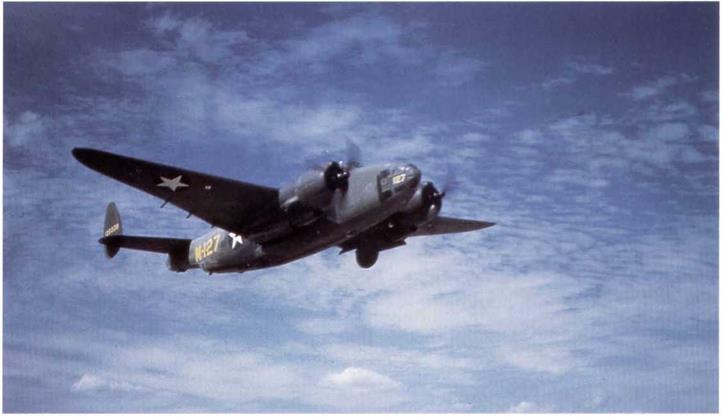
Lockheed B-34,41-38206, in Dark Olive Drab and Neutral Gray, with yellow M-127 on fuselage, taking off. The number’ 127’ is repeated on the nose in yellow. (USAF via Gerry R. Markgraf)
|
|

Stinson L-S-VW, 42-14809, was one of the hatch of 275 originally ordered as 0-62s in 1942. (USAF)
|
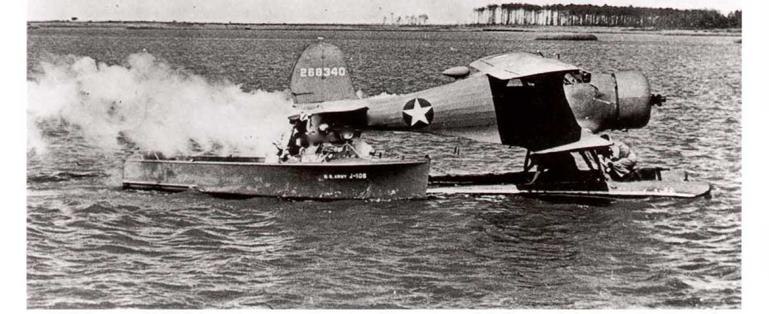
a certain way, that is no reason for us changing ours, for the British type of camouflage has been proven both visually and photographically as being inferior to (he Air Corps Board findings”. (Note: there is no evidence available to support this very chauvinistic statement in any of the AC Board reports-author).
The Dir. of War Org. and Movement reported the next day that tests were to be run on anti-submarine aircraft camouflage at Langley Field, VA. The Dir. of Tech. Services had emphasized that the AC Board findings did not cover this application as operations were conducted between ЗШ. Ю and 300 feet altitude and no such tests had been made by the AC Board. Moreover, current regulations governing camouflage painting of all aircraft in a uniform manner were a result of the AC Board findings which were based on tests made during peace time in the southeastern United States. Army aircraft were currently being used all over the world under conditions which the peace time study did not cover.
|
– PS
|
‘* *1
|
|
|
jfjfL ям ‘■ъ.
|
|
|
|
Ґ«*=
|
|
|
|
Beech VC-43B-BH, 42-68340, one of many impressed Beech B-17s. This one was ex NC20793. This photograph ts very unusual in showing the aircraft on Edo floats next to an Army flotation device. (Harry Gann)
|
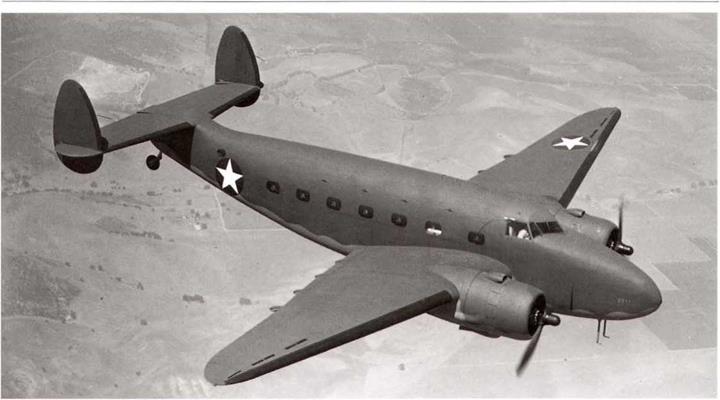
Lockheed C-57B-LO, 43-3271. This transport was a R-1830 engined variant of the C-56 and was Urckheed constructor no. 2211, (Harry Gann)
|
In later comments, a discussion was held concerning a disagreement between Langley Field and Eglin Field re camouflaging of aircraft. The Dir. of War Org. and Movement recommended the use of the Eglin Field’s recommended anti-submarine camouflage when hostile aircraft would not be encountered. However, in combat areas, the camouflage of anti-submarine aircraft should be left to the discretion of the local commander. Gen. Fairchild agreed with this recommendation but believed that the local commander should be familiar with all pertinent information. After further contact with Eglin Field, the Dir. of War Org and Movement stated that they had recommended that all under surfaces of anti-submarine warfare aircraft should be painted insignia white, with all other surfaces painted neutral gray.
JAC Standardizes Aircraft Camouflage Colors, July 28,1942.
On July 28, 1942, the JAC committee on standardization reviewed a chart containing all of the colors being used by the USAAF, the Navy Bureau of Aeronautics, and the British. It had been prepared by using the Standard Color Cards of the respective services. The USAAF member. Col. Schneider (who had run the AC Board Study No. 42 on Camouflage), explained the need for simplifying as much as possible the multiplicity of colors used by the different services. It was pointed out that many of the colors presently in use differed from one another only by a slight degree of shade.
|

Lockheed A-29, AM898, was built as an RAF Hudson Mk. V. Finished in RAF Dark £arth, Dark Green, and Sky, it was another aircraft returned to the AAF. It is seen with a PT-17 behind and a C-78, 41-283 to the left. (IISAF via Gerry R. Markgruf)
|
The committee agreed that a single standardized Color Card would greatly simplify the entire system. They made the following recommendations:
 Accepted as standard color.
Accepted as standard color.
(1) British Dull Red Navy Insignia Red for further tests
(2) Navy Insignia Blue
(3) Navy Insignia White
(4) Army Black
(5) British Azure Blue
(6) British Extra Dark Sea Gray, name to be changed to Sea Gray
(7) Navy Light Gray
(8) Navy Orange Yellow
(9) British Middlestone, Army Sand *
(10) British Dark Earth.
(11)  Army Dark Olive Drab
Army Dark Olive Drab
(12) Army Medium Green **
(13) British Sky Type S Gray
Note: * These to be retained pending a report from the British showing the results of Middlestone use in North Africa..
** The Army to investigate the possibility of eliminating their Medium Green entirely.
The committee requested that the Aeronautical Board be asked to prepare a new AN Standard Color Card for non-specular camouflage colors, based on the above decisions. This standard be used for finishing all camouflaged aircraft for use by Army, Navy, and British. (Note: this duly resulted in the new ANA Bulletin No. 157, to be discussed later – author).
|
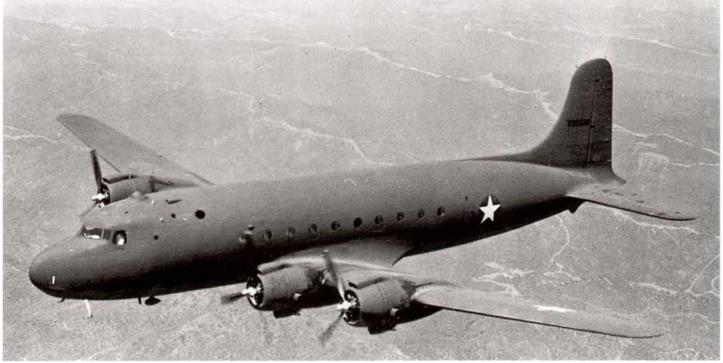
Douglas C-54-DO, 42-32936, was the tenth aircraft on the production line. This is one of the original batch of DC-4s built for United Airlines and American Airlines, but impressed while on the production line due to the war. (Nick Williams)
|
|
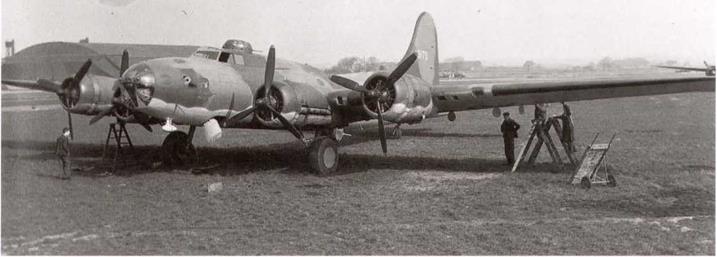
|
Boeing B-17E-BO, one of the first B-17s to arrive in England at the beginning of the Eighth Air Force in the summer of 1942. It is one of a batch finished in two tone camouflage with sky undersurfaces. (USAF)
|
|
|
Boeing B-17E-BO, 41-9023, of the 414 BS/97 BG, was named “Yankee Doodle". It is shown having regular maintenance work performed on its engines. (March AFB Museum)
|
|
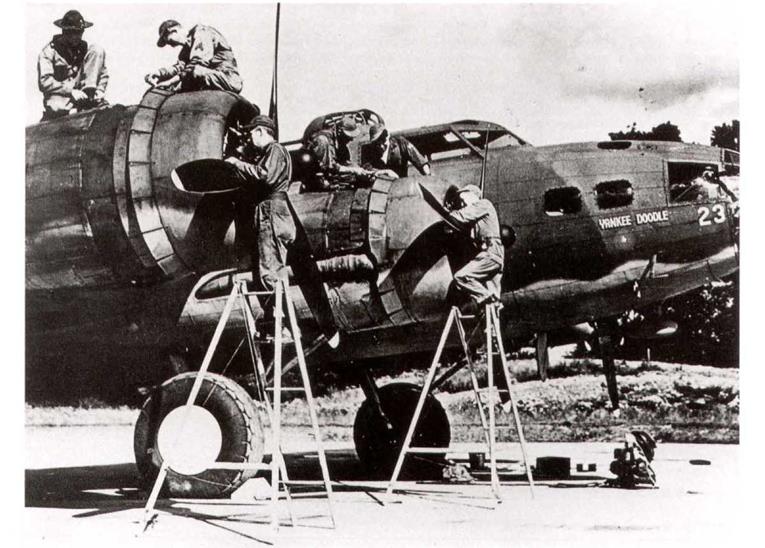















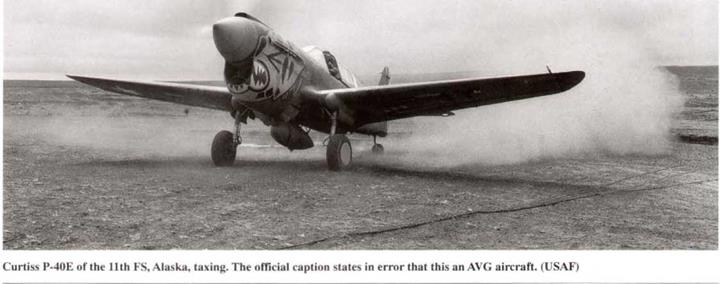





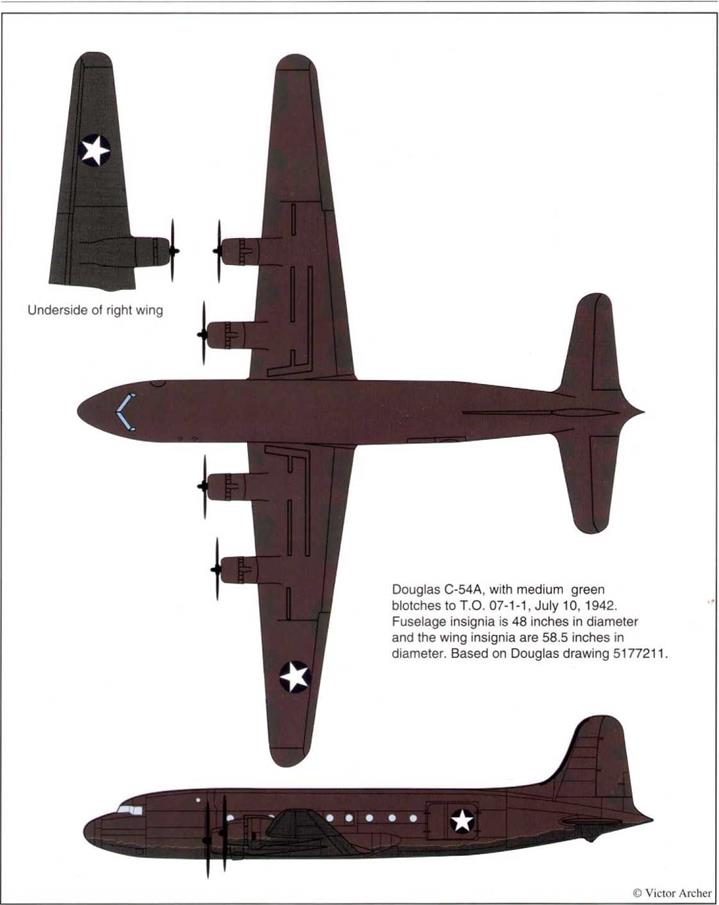
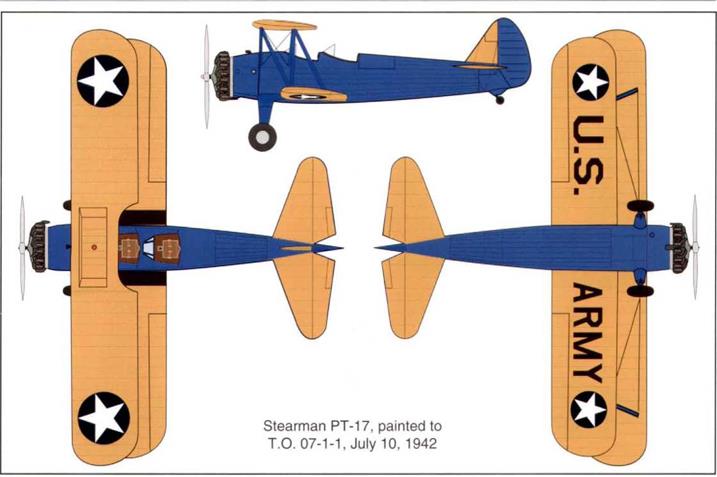


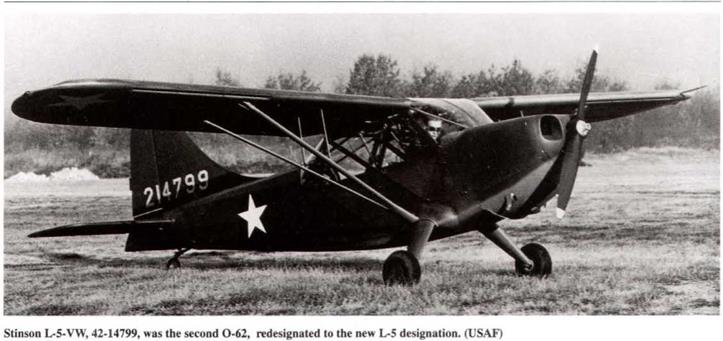





 Accepted as standard color.
Accepted as standard color. Army Dark Olive Drab
Army Dark Olive Drab


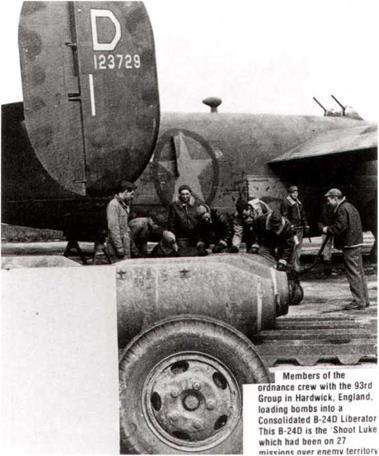 Consolidated B-24D-1-CO, 41-23729, was the «2nd B-24-D-1 built. It is seen here in April 1943, serving with the 93rd BG, Eighth Air Force. Note that the yellow ring has been painted over with insignia blue on the fuselage grayed-out cocarde. The vertical line on the fin indicates the first squadron in the group, the 328th BS. (USAF)
Consolidated B-24D-1-CO, 41-23729, was the «2nd B-24-D-1 built. It is seen here in April 1943, serving with the 93rd BG, Eighth Air Force. Note that the yellow ring has been painted over with insignia blue on the fuselage grayed-out cocarde. The vertical line on the fin indicates the first squadron in the group, the 328th BS. (USAF)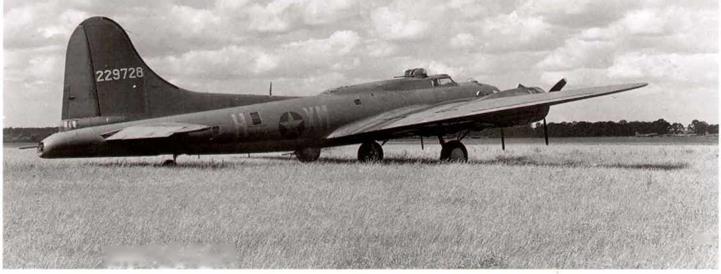 Consolidated B-24D-1-CO, 41-23711, Aircraft *B’, in Dark Olive Drab and Neutral Gray, “Jerk’s Natural”, of the 328th BS, 93rd BG, Eighth Air Force. She had been deployed to North Africa and returned, hence the RAF fin flash. The previous yellow outer ring on the fuselage insignia has been repainted Insignia Blue. (USAF)
Consolidated B-24D-1-CO, 41-23711, Aircraft *B’, in Dark Olive Drab and Neutral Gray, “Jerk’s Natural”, of the 328th BS, 93rd BG, Eighth Air Force. She had been deployed to North Africa and returned, hence the RAF fin flash. The previous yellow outer ring on the fuselage insignia has been repainted Insignia Blue. (USAF)




















